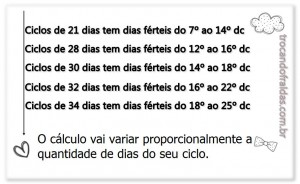It’s only possible to get pregnant during the fertile window, right? So how do you know what those fertile days are? The fertility calendar can be very helpful for this task. One basic requirement for the calendar to work is to have a cycle that is at least somewhat regular. This makes it possible to predict ovulation and the fertile window more accurately and know the best days to have sex.
The fertility calendar identifies the fertile days through a very simple calculation, because we know that ovulation happens between the 12th and 16th day before your next period. That’s because the luteal phase (post-ovulatory phase)1 needs a few days to work and accommodate a possible pregnancy, if fertilization happens due to the stimulation of progesterone and the corpus luteum.
How to Use the Fertility Calendar?
Start the fertility calendar on the very first day of your menstrual flow. The day to mark is the first day of full bleeding with flow; a light spot or brownish discharge isn’t considered the first day of your cycle. From that day, you should record on a sheet or calendar the days you were menstruating and, depending on your cycle, do the calculation to use the calendar to get pregnant – or not, since it also helps for avoiding pregnancy.
Let’s say a woman has a 32-day cycle and a fixed 14-day luteal phase, she would ovulate as follows: 32-14=18 so the 18th day of her cycle would, most likely, be her most fertile day. Now, a woman who has a 21-day cycle and a fixed 14-day luteal phase: 21-14=7 so the 7th day of the cycle would be that woman’s most fertile day.
As most women aren’t sure of the length of their luteal phase, the best thing is to include a 7-day window around the fertile day. We suggest counting like this: 3 days before your most fertile day and 4 days after, to cover the period when the egg could be fertilized and prevent missing your opportunity, increasing chances of pregnancy.
Variable Cycles
Women with cycles that vary in length2, for example, one cycle of 30 days and another of 32 days, should add this variation to both sides in the calculation. So, a woman who would ovulate on the 16th day of her cycle should consider her fertile window to span from the 11th to the 21st day of the cycle.
Complicated? A little, but basically you should remember that ovulation occurs within this period, 12 to 16 days before your period, so sexual intercourse during this time can most easily lead to pregnancy. Cervical mucus also helps to identify ovulation, so pay attention to vaginal moisture3. Now, if you have difficulty noticing the signs, a great ally is the ovulation test. Just like a pharmacy pregnancy test, it’s simple to use and shows very clear results.
With them, you can find out if you have ovulated, are ovulating, or are about to ovulate. You can learn more about Famivita’s ovulation tests here. Also, a menstrual tracking app like APP Paula can give you extra help to know the best time to have sex and boost your chances of pregnancy.
Fertility Calendar to Determine Baby’s Sex
The fertility calendar can also help determine the baby’s sex. For example, if the couple wants a girl and knows their most fertile day is the 12th of the cycle, they should have intercourse 1 or 2 days before that date.
Now, to increase chances of having a boy using the calendar, have sex exactly on the most fertile days, that is, when ovulation actually happens. And look, to calculate your fertile window you can also use the fertility calculator available here at Famivita.
I Got My Period on Day X – What Is My Fertile Window?
Estimated table for a regular 28-day cycle:
| First Day of Period | Probable Fertile Period |
| 1 | 15 |
| 2 | 16 |
| 3 | 17 |
| 4 | 18 |
| 5 | 19 |
| 6 | 20 |
| 7 | 21 |
| 8 | 22 |
| 9 | 23 |
| 10 | 24 |
| 11 | 25 |
| 12 | 26 |
| 13 | 27 |
| 14 | 28 |
| 15 | 29 |
| 16 | 30 |
| 17 | 31 |
| 18 | 01 |
| 19 | 02 |
| 20 | 03 |
| 21 | 04 |
| 22 | 05 |
| 23 | 06 |
| 24 | 07 |
| 25 | 08 |
| 26 | 09 |
| 27 | 10 |
| 28 | 11 |
| 29 | 12 |
| 30 | 13 |
| 31 | 14 |
Readers’ Questions:
How does the calendar work for not getting pregnant?
Using the calendar method to avoid pregnancy is a common option for women who don’t want to use contraceptive methods like the birth control pill, for example. It works the same way as the calendar for conception, and the couple should avoid having sex during the fertile window. However, as we’ve seen, the calendar doesn’t work with exact dates, and you need to know your cycle very well to truly avoid a pregnancy.
See also: Best Positions to Get Pregnant – Combining Pleasure with Conception













pregnancy test